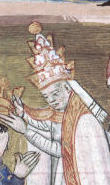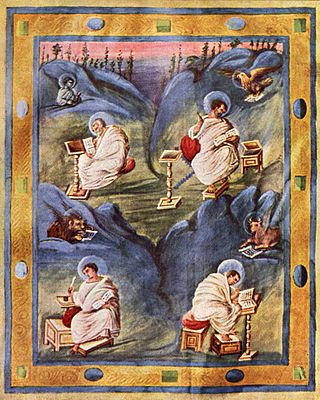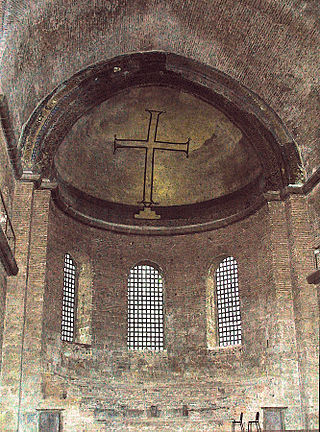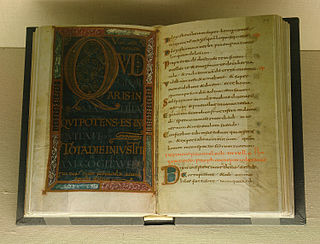
Alcuin of York – also called Ealhwine, Alhwin, or Alchoin – was a scholar, clergyman, poet, and teacher from York, Northumbria. He was born around 735 and became the student of Archbishop Ecgbert at York. At the invitation of Charlemagne, he became a leading scholar and teacher at the Carolingian court, where he remained a figure in the 780s and 790s. Before that, he was also a court chancellor in Aachen. "The most learned man anywhere to be found", according to Einhard's Life of Charlemagne, he is considered among the most important intellectual architects of the Carolingian Renaissance. Among his pupils were many of the dominant intellectuals of the Carolingian era.

Charlemagne was King of the Franks from 768, King of the Lombards from 774, and Emperor of the Carolingian Empire from 800, holding all these titles until his death in 814. Charlemagne succeeded in uniting the majority of Western Central Europe, and was the first recognized emperor to rule in the west after the fall of the Western Roman Empire approximately three centuries earlier. Charlemagne's rule saw a program of political and social changes that had a lasting impact on Europe in the Middle Ages.

Pope Adrian I was the bishop of Rome and ruler of the Papal States from 1 February 772 to his death. He was the son of Theodore, a Roman nobleman.

The Second Council of Nicaea is recognized as the last of the first seven ecumenical councils by the Eastern Orthodox Church and the Catholic Church. In addition, it is also recognized as such by the Old Catholics, and others. Protestant opinions on it are varied.

Irene of Athens, surname Sarantapechaena, was Byzantine empress consort to Emperor Leo IV from 775 to 780, regent during the childhood of their son Constantine VI from 780 until 790, co-ruler from 792 until 797, and finally empress regnant and sole ruler of the Eastern Roman Empire from 797 to 802. A member of the politically prominent Sarantapechos family, she was selected as Leo IV's bride for unknown reasons in 768. Even though her husband was an iconoclast, she harbored iconophile sympathies. During her rule as regent, she called the Second Council of Nicaea in 787, which condemned iconoclasm as heretical and brought an end to the first iconoclast period (730–787). Her public figure was very polarizing during her 5 year reign, as most saw it as wrong for a woman to rule solely. Her reign as such made her the first ever empress regnant, ruling in her own right, in Roman and Byzantine imperial history.

Religious images in Christian theology have a role within the liturgical and devotional life of adherents of certain Christian denominations. The use of religious images has often been a contentious issue in Christian history. Concern over idolatry is the driving force behind the various traditions of aniconism in Christianity.

Paschasius Radbertus (785–865) was a Carolingian theologian and the abbot of Corbie, a monastery in Picardy founded in 657 or 660 by the queen regent Bathilde with a founding community of monks from Luxeuil Abbey. His most well-known and influential work is an exposition on the nature of the Eucharist written around 831, entitled De Corpore et Sanguine Domini. He was canonized in 1073 by Pope Gregory VII. His feast day is April 26. His works are edited in Patrologia Latina vol. 120 (1852) and his important tract on the Eucharist and transubstantiation, De Corpore et Sanguine Domini, in a 1969 edition by B. Paulus, published by Brepols.
Iconodulism designates the religious service to icons. The term comes from Neoclassical Greek εἰκονόδουλος (eikonodoulos), meaning "one who serves images (icons)". It is also referred to as iconophilism designating a positive attitude towards the religious use of icons. In the history of Christianity, iconodulism was manifested as a moderate position, between two extremes: iconoclasm and iconolatry.

Carolingian art comes from the Frankish Empire in the period of roughly 120 years from about 780 to 900—during the reign of Charlemagne and his immediate heirs—popularly known as the Carolingian Renaissance. The art was produced by and for the court circle and a group of important monasteries under Imperial patronage; survivals from outside this charmed circle show a considerable drop in quality of workmanship and sophistication of design. The art was produced in several centres in what are now France, Germany, Austria, northern Italy and the Low Countries, and received considerable influence, via continental mission centres, from the Insular art of the British Isles, as well as a number of Byzantine artists who appear to have been resident in Carolingian centres.
Agobard of Lyon was a Spanish-born priest and archbishop of Lyon, during the Carolingian Renaissance. The author of multiple treatises, ranging in subject matter from the iconoclast controversy to Spanish Adoptionism to critiques of the Carolingian royal family, Agobard is best known for his critiques of Jewish religious practices and political power in the Frankish-Carolingian realm. He was succeeded by Amulo of Lyons.

In the practice of religion, a cult image is a human-made object that is venerated or worshipped for the deity, spirit or daemon that it embodies or represents. In several traditions, including the ancient religions of Egypt, Greece and Rome, and modern Hinduism, cult images in a temple may undergo a daily routine of being washed, dressed, and having food left for them. Processions outside the temple on special feast days are often a feature. Religious images cover a wider range of all types of images made with a religious purpose, subject, or connection. In many contexts "cult image" specifically means the most important image in a temple, kept in an inner space, as opposed to what may be many other images decorating the temple.

Theodulf of Orléans was a writer, poet and the Bishop of Orléans during the reign of Charlemagne and Louis the Pious. He was a key member of the Carolingian Renaissance and an important figure during the many reforms of the church under Charlemagne, as well as almost certainly the author of the Libri Carolini, "much the fullest statement of the Western attitude to representational art that has been left to us by the Middle Ages". He is mainly remembered for this and the survival of the private oratory or chapel made for his villa at Germigny-des-Prés, with a mosaic probably from about 806. In Bible manuscripts produced under his influence, the Book of Baruch and the Letter of Jeremiah became part of the Western (Vulgate) Bible canon.

The Council of Frankfurt, traditionally also the Council of Frankfort, in 794 was called by Charlemagne, as a meeting of the important churchmen of the Frankish realm. Bishops and priests from Francia, Aquitaine, Italy, and Provence gathered in Franconofurd. The synod, held in June 794, allowed the discussion and resolution of many central religious and political questions.

The Byzantine Iconoclasm were two periods in the history of the Byzantine Empire when the use of religious images or icons was opposed by religious and imperial authorities within the Ecumenical Patriarchate and the temporal imperial hierarchy. The First Iconoclasm, as it is sometimes called, occurred between about 726 and 787, while the Second Iconoclasm occurred between 814 and 842. According to the traditional view, Byzantine Iconoclasm was started by a ban on religious images promulgated by the Byzantine Emperor Leo III the Isaurian, and continued under his successors. It was accompanied by widespread destruction of religious images and persecution of supporters of the veneration of images. The Papacy remained firmly in support of the use of religious images throughout the period, and the whole episode widened the growing divergence between the Byzantine and Carolingian traditions in what was still a unified European Church, as well as facilitating the reduction or removal of Byzantine political control over parts of the Italian Peninsula.
Freculf, a Frankish ecclesiastic, diplomat and historian, was a pupil of the palace school of Aachen during the reign of Charlemagne and Bishop of Lisieux from about 824 until his death. He is now best remembered for his universal chronicle, the Twelve Books of Histories, which is a source of information about the conversion of Gaul and the history of the Franks. Chronicles such as that of Freculf attempted to show world history from Creation to the present, but most history writing in the eighth and ninth centuries was considerably more local and specific.

Claudius of Turin was the Catholic bishop of Turin from 817 until his death. He was a courtier of Louis the Pious and was a writer during the Carolingian Renaissance. He is most noted for teaching iconoclasm, a radical idea at that time in Latin Church, and for some teachings that prefigured those of the Protestant Reformation. He was attacked as a heretic in written works by Saint Dungal and Jonas of Orléans.
Smaragdus of Saint-Mihiel< OSB was a Benedictine monk of Saint-Mihiel Abbey near Verdun. He was a significant writer of homilies and commentaries.

For about a thousand years, in obedience to interpretations of specific Bible passages, pictorial depictions of God in Western Christianity had been avoided by Christian artists. At first only the Hand of God, often emerging from a cloud, was portrayed. Gradually, portrayals of the head and later the whole figure were depicted, and by the time of the Renaissance artistic representations of God the Father were freely used in the Western Church.
The Epistola de litteris colendis is a well-known letter addressed by Emperor Charlemagne to Abbot Baugulf of Fulda, probably written sometime in the late 780s to 800s (decade), although the exact date is still debatable. The letter is a very important witness to the Carolingian educational reforms during the Carolingian Renaissance from the late 8th century to the 9th century. The letter shows Emperor Charlemagne's interest in promoting learning and education within his empire.

The Dagulf Psalter is a late 8th-century Carolingian manuscript, and is one of the earliest examples of a codex emanating from the Court School of Charlemagne. The 161 page codex is written entirely in golden Carolingian minuscule script, and contains the Old Testament Psalms as well as a selection of Frankish Canticles. The Psalter is believed to have been created by the scribe Dagulf in 793-795 CE as a gift from Charlemagne to Pope Adrian I.















